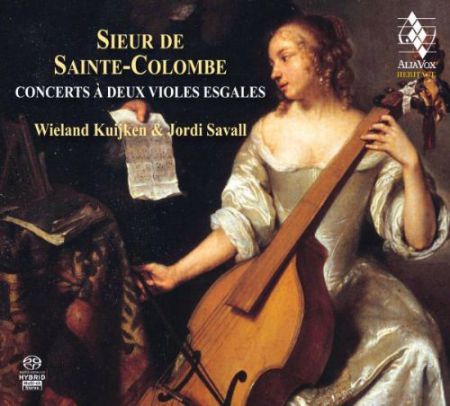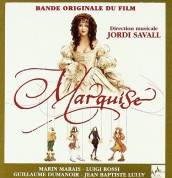Concerts a deux violes esgales - SACD
Tükendi
Bu Ürün Stoklarımıza Girince Haberdar Olmak İster Misiniz?
(+) Stoklara Girince Haber Ver
(+) Stoklara Girince Haber Ver
Ürün Hakkında
Barkod: 7619986398853
, Katalog No: AVSA9885 , Firma: Alia Vox
, Yayınlanma Tarihi:
2012
Tür:
Klasik Müzik
Format Türü: SACD, Format: 2 SACD
ENGLISH
The Double Life of Monsieur de <span data-scayt_word="Sainte" data-scaytid="69">Sainte</span> <span data-scayt_word="Colombe" data-scaytid="70">Colombe</span><br /> Nothing or next to nothing was known about Monsieur de <span data-scayt_word="Sainte-Colombe" data-scaytid="71">Sainte-Colombe</span> ' not even his first name ' and the mystery surrounding his person only intensified the mystery of his music: the Concerts <span data-scayt_word="à" data-scaytid="74">à</span> <span data-scayt_word="deux" data-scaytid="75">deux</span> <span data-scayt_word="violes" data-scaytid="76">violes</span>, which are the only pieces that have come down to us. He was known to violists as the inventor of the seventh string that was added to the bass viol of the Baroque era in France. It was gathered that he had two daughters because he was known to have given concerts with them. And <span data-scayt_word="Titon" data-scaytid="77">Titon</span> du <span data-scayt_word="Tillet" data-scaytid="78">Tillet</span> had recounted the pleasing story of Marin <span data-scayt_word="Marais" data-scaytid="79">Marais</span> coming to listen to his master in secret, hidden under the hut in a mulberry tree where the latter "played the viol more peacefully and more delectably". That was all. And on top of this mixture of ignorance and charming anecdotes, there was also his music ' strange, somehow distant and aloof, grave and erudite, unlike any other known genre, impossible to relate either to a particular school or a specific type of composition, <span data-scayt_word="pitchforked" data-scaytid="80">pitchforked</span> into the history of music.<br /> It was then that a writer and a film director ' a producer of words and a producer of pictures ' came on the scene: suddenly, a novel and a film put faces to Monsieur de <span data-scayt_word="Sainte-Colombe" data-scaytid="72">Sainte-Colombe</span> and his daughters, built the hut and filled it "delectably" with music. Monsieur de <span data-scayt_word="Sainte-Colombe" data-scaytid="73">Sainte-Colombe</span> had an identity, and what was most astonishing was that his personality in the film was not so much the result of the two well-known anecdotes (his daughters, the hut) as of his music itself. Its gravity became an expression of the seclusion, the reserve and the brusqueness of a man who had withdrawn into himself and was engrossed in transforming into sound all his nostalgia, despondency and unfulfilled desires. If was a biography stemming from the music: Les Regrets, Les <span data-scayt_word="Pleurs" data-scaytid="81">Pleurs</span>, La <span data-scayt_word="Rêveuse" data-scaytid="82">Rêveuse</span> had given rise to a tragedy; its images and words were born from the eloquence without words of the music itself.<br /> One thing led to another, and the imaginary biography of Sainte-Colombe gave way to other versions of his life, which were superimposed on the first. First of all, there was what appears to have been a false lead, published by the musicologist Pierre Guillot in Le Monde, in January, 1992, announcing that Monsieur de Sainte-Colombe really did exist, that his true name was Augustin Dautrecourt, and that he lived not in the Bièvre valley, but in Lyons, where he taught music in the 1660s to the "demoiselles de la Charité", a kind of Vivaldi on the banks of the Saône who went by the pseudonym of Sainte-Colombe. Apparently, the sources consulted by Mr. Guillot were not very reliable and his thesis was rapidly refuted... Finally, more recent research has unearthed a third hypothesis, according to which his first name was Jean, even though all the musical sources refer to him simply as Sieur de Sainte-Colombe, or Mr. de Sainte-Colombe the elder, since he is known to have had a son, known as Mr. Sainte-Colombe the younger (around 1660-1720), also a violist and composer, whose compositions have been traced to a manuscript housed in the library of Durham Cathedral in England. What is most surprising is that all this makes no difference. The imaginary Sainte-Colombe that we knew before seeing the film has not been diminished by the character invented by Pascal Quignard and Alain Corneau; nor are we bothered by the fact that this new character was not real either. All these images quite happily coexist: all that really matters is the music.<br /> In the end, we realize that Monsieur de Sainte-Colombe not only gave the French viol the seventh string that makes it so original: he also gave it its soul. He was the first person to have grasped the viol's specificity and to have translated it into music. This stamp compelled recognition among all the violists who came after him in France. Until its disappearance (much deplored by Hubert Le Blanc), French viol music was characterized not only by the instrument's distinctive technique, the use of polyphony, the frets, the shape of the bridge, and the seventh string., but also by its elegiac, crepuscular, nocturnal (in Fauré's sense of the word) nature: it was a music of light and shade. French viol music always retained that gravity, inwardness and secrecy which are to be found, for example, in Couperin's La Pompe Funèbre and Marin Marais's Les Voix Humaines. Even when Forqueray, with his nobility and his forcefulness, had drawn it towards virtuosity and brilliance, even when Caix d'Hervelois had given it a lighter, more amiable tone, there still remained something inward and silent about the French viol, which we undoubtedly owe to Monsieur de Sainte-Colombe.<br /> PHILIPPE BEAUSSANT<br /> Translated by Marie PardoeEser Listesi
- CD: 1
- Concert XXVII: Bourrasque
- Concert XLVIII: Le raporte
- Concert XLI: Le retour
- Concert XLIV: Tombeau les regrets
- 19. Joye des Elizees - Les Elizees
- 01:14

- Concert LIV: (La) Dubois
- CD: 2
- Concert: VIII: La conference
- Concert: XLII: Le raporte
- Concert III: Le Tendre
- Concert LI: (La) Rougeville
- Concert LXII: Le Figure
- 21. Le Figure
- 05:02

Katkıda Bulunanlar
|
|
Bu Ürünler İlginizi Çekebilir







